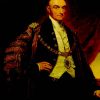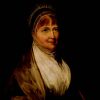Sir John Pirie was a wealthy British shipping magnate at the time the South Australian Colonization Bill passed in the British Houses of Parliament. He had several years’ experience on the London Emigration Committee, reflecting a philanthropic and commercial interest in the relief of poverty and distress through the process of emigration to the ‘New World’.
When Edward Gibbon Wakefield’s grand plan for colonising South Australia looked like faltering for want of subscriptions, George Fife Angas formed the South Australian Company, inviting John Pirie (later Sir John) to join John Rundle MP, Charles Hindley MP, Henry Waymouth and others as fellow directors of the company. Hence Pirie’s honour of a street name in the city of Adelaide.
John Pirie was born the eldest son of John Pirie Snr, on 28 September 1781 at No. 6 Bridgend in Duns, Berwick on Tweed. He was of a similar age to Colonel Robert Torrens, Governor John Hindmarsh and Thomas Fowell Buxton, making him one of the more senior figures associated with the colony.
Pirie married Jean Nichol, the daughter of Robert and Elizabeth Nichol (nee Dickson). Theirs was a strong Scottish shipbuilding family and Pirie was immediately taken into the business upon the marriage. Eventually taking control, the family business increased to the point where he began trading as John Pirie and Co.
By the 1830s Pirie was described as a merchant shipbroker who owned as many as twenty ships. However, he probably came to the marriage with some status as a highly regarded and reputable plasterer.
Appointed as Sheriff for Middlesex in 1831, he served as an alderman for Cornhill in London from 1834 until his death in 1851. To be an alderman in London one had to be the master or chief representative of one of the city’s livery companies, there being 107 such companies still operating today. They are vestiges of the guilds from pre-industrial Britain and Europe. Pirie became the ‘Master of the Plaisterers’ and a large oil portrait of him still hangs in the Plaisterers’ impressive Livery Hall at No. 1 London Wall in the heart of the city.
The Worshipful Company of Plaisterers was first granted their charter by King Henry VII in 1501. The collective body of aldermen from each livery company constitutes a body known as Common Hall, which meets at the Guildhall in London every 29 September (Michaelmas Day) to elect the Lord Mayor of London. It has done so since 1385.
Between 1834 and 1840 John Pirie was approached to run for mayor on several occasions, but for reasons unknown he usually declined. He was so popular, however, that by 1841 he finally agreed to the proposition. He became London’s 568th Lord Mayor. As he was in office in the year of the birth of Edward VII, the Prince of Wales, Queen Victoria elevated him to the baronetcy on 13 April 1842. Thereafter he was known as Sir John Pirie.
Just how Pirie and his wife Lady Jean Pirie became involved with the work of Elizabeth Fry, the great prison reformer, remains obscure, but at some point both John and Jean were involved with the London Refuge for the Destitute, an organisation first established in 1806 and later taken up with enthusiasm by Zachary Macaulay and William Wilberforce.
By the early 1820s this organisation, which concerned itself with the welfare and rehabilitation of young destitute men and women, many of whom had been incarcerated for criminal offences, petty and otherwise, had grown to such significance and influence that those subscribing to its continuation and support were among the most powerful and wealthy in the land.
Wilberforce and Fry were at the forefront and Sir John Pirie and his wife not far behind. The Duke of York assumed the presidency and the one-time Prime Minister Spencer Perceval became Vice President.
John and Jean Pirie were inextricably involved in the work of ministering to destitute and despondent young women in Newgate and elsewhere. They threw their personal energy and wealth at the burgeoning problems of economic hardship and poverty in Britain, although Elizabeth Rushen claims that John Pirie could only be described as the ‘consummate merchant’ and not in any way evangelical.
By the 1820s the socialist ideas of William Cobbett, the emigration theories of Wakefield and the imperatives of the political economists all found a voice on new ways to reduce the high levels of unemployment and economic alienation in the cities. Assisted emigration might at least go some of the way towards solving the problems.
In 1831, a committee from the House of Lords, which had been deliberating on the Poor Laws and economic distress in Britain, set about examining how potential revenue from the issue of land grants in New South Wales might support an assisted passage scheme for interested emigrants. The members noted the shortage of women in Australia and subsequently commissioned two ships to transport young women to the colonies. It was a way of relieving distress at home.
The first ship commissioned, the Princess Royal, was bound for Hobart. Elizabeth Fry’s brother William Fry supervised the process on behalf of the commissioners and the ship sailed with her cargo of young women in 1832.
The House of Lords Commission then disbanded but not before entrusting the London Refuge for the Destitute to take over the operation. The patrons of the refuge immediately formed a subcommittee known as the London Emigration Committee. John Pirie enjoyed the confidence of the members and became one of its principals.
Agents were appointed in the colonies to place the young women on arrival in Australia, and some of Pirie’s ships were immediately pressed into service. Others like the Charles Kerr were purchased and especially fitted out to suit emigrant accommodation. This ship sailed for the South Australian Colonization Commission, arriving in Adelaide on 17 June 1840 carrying about 200 passengers.
Some of Sir John Pirie’s other ships which sailed to South Australia included the Canton, the John Pirie, the Duchess of Northumberland and the Amelia Thompson.
Sir John Pirie might be described as an eclectic, especially given the diversity of his business interests and directorships. He was a director of the South Australian Company and subsequently a director of the South Australian Banking Company. Furthermore, when the British Government resumed control of the affairs of the colony, declaring it to be the Province of South Australia, Sir John became a foundation member of the newly formed South Australian Society and a signatory to the Colonial Land and Emigration Commission in 1840.
During his term as Lord Mayor of London Pirie became a director of the P&O Shipping Company (Peninsular and Oriental Navigation Company). By 1848 he had become Deputy Chairman for P&O and had the honour of welcoming both Queen Victoria and Prince Albert aboard the company’s Hindostan as she lay off the Isle of Wight near the Queen’s home at Osborne. Throughout all these activities Pirie maintained a continuing interest in the emigration of young women to the colonies, even to the point of joining Caroline Chisholm’s 1847 to 1848 Society for the Promotion of Colonization.
It is difficult to estimate the degree of influence Lady Jean Pirie had on Sir John’s life, but unlike most Victorian wives who generally remained persona non grata, she was known publicly for her charitable works and tireless support of Elizabeth Fry and her good works under the auspices of the Elizabeth Fry Society, the London Refuge for the Destitute, the London Emigration Committee and the Home and Colonial School Society.
In the year of his mayoralty Sir John Pirie, who usually maintained a bipartisan political stance, ran unsuccessfully for a seat in parliament as a Tory. London boroughs were highly contested and difficult to win. Not to be deterred in any way, Pirie and others from the London Emigration Committee launched into more philanthropic work. He took over the chairmanship of the Committee and from 1842 until his death was elected President of the Board of Governors of St Thomas’ Hospital in London. Prince Albert was patron.
On 26 February 1851 Sir John Pirie died at Champion Hill, Camberwell, a wealthy, commercially astute but socially responsible and magnanimous human being.







Comments